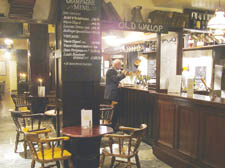|
|
 |
| |

Family values: Davy’s at St James’ in Crown Passage, Pall Mall |
Painting the town red and white: a story of wine bars
Wine-drinking by the glass was unheard of in London 40 years ago... and then a family run wine merchant started a new trend
WHILE traditional wine merchants and wine bars in much of London have been consigned to history there is one part of the capital where these traditional businesses still thrive: in that hub of global modernity and scourge of convention the City.
The place where even the skyline appears to change on a weekly basis is the long-standing home to a clutch of traditional wine merchants and their wine bars.
Corney and Barrow, Balls Brothers and the granddaddy of them all, Davy’s, appear to be thriving. Between them they have in the region of 60 wine bars, mostly in the City and its environs. All three are family owned businesses and were founded more than a 100 years ago, They are born of a long line of English families whose role in the history of the international wine trade is as great and as influential as the aristocratic Bordeaux wine families who created the great chateau wines.
Last week, James Davy invited us – along with a number of other journalists, to a tasting of the company’s new range of ‘own label’ wines, three whites and three reds, all French, and sold under the family name. Davy’s Wine Merchants, established in 1870, have 36 wine bars in London.
James’s father opened London’s first wine bar in Borough High Street in 1965. The big brewers dominated alcohol retailing at the time and persuaded local magistrates to reject the licence application.
Davy senior used his membership of the City of London Vintners Company – one of the 12 great City Livery Companies – to overcome the problem. The Vintners had the power to issue licences under an obscure 15th-century privilege.
Offering an alternative to the countless modern postwar hotels and restaurants that dominated London at the time, the new wine bar aimed to take the City worker away from modern insubstantial plasticity back to solid Victorian London. Dark wood instead of garish plastic, proper seating and even sawdust on the floor greeted and eventually delighted a generation of City clientele.
For the first six months, the new wine bar stood practically empty. Borough High Street was not a fashionable place and wine-drinking by the glass was unknown in London. But this was the Swinging Sixties and ‘new’ was in; soon Davy’s wine bar became the ‘in thing’. Business and professional people keen to impress their clients began to realise that just across the river lay an exciting new world.
Davy’s was instrumental in launching a new trend. James Davy is determined to maintain the family traditions. While he wishes to use the Davy name as a brand he is, he says, determined not to undermine the core values he has inherited from his predecessors.
He will stick with the family tradition of simple, good quality wines and food. Potted shrimps, Caesar salad, bangers and mash, seafood platters and charcoal grilled rib-eye steaks will continue to dominate the menu.
Their six new private label wines from Mâconnais, Bordeaux and Burgundy underline this focus on tradition.
The families who for generations ran our major food and wine businesses may have succumbed to unfettered global capital. But the survival of the City wine merchants shows that smaller companies offering something original or special, who build on worthwhile traditions, will survive and thereby help challenge the unhealthy domination of the market by big companies. |
 |
|
| |

|
|
 |
|









